Paper Menu >>
Journal Menu >>
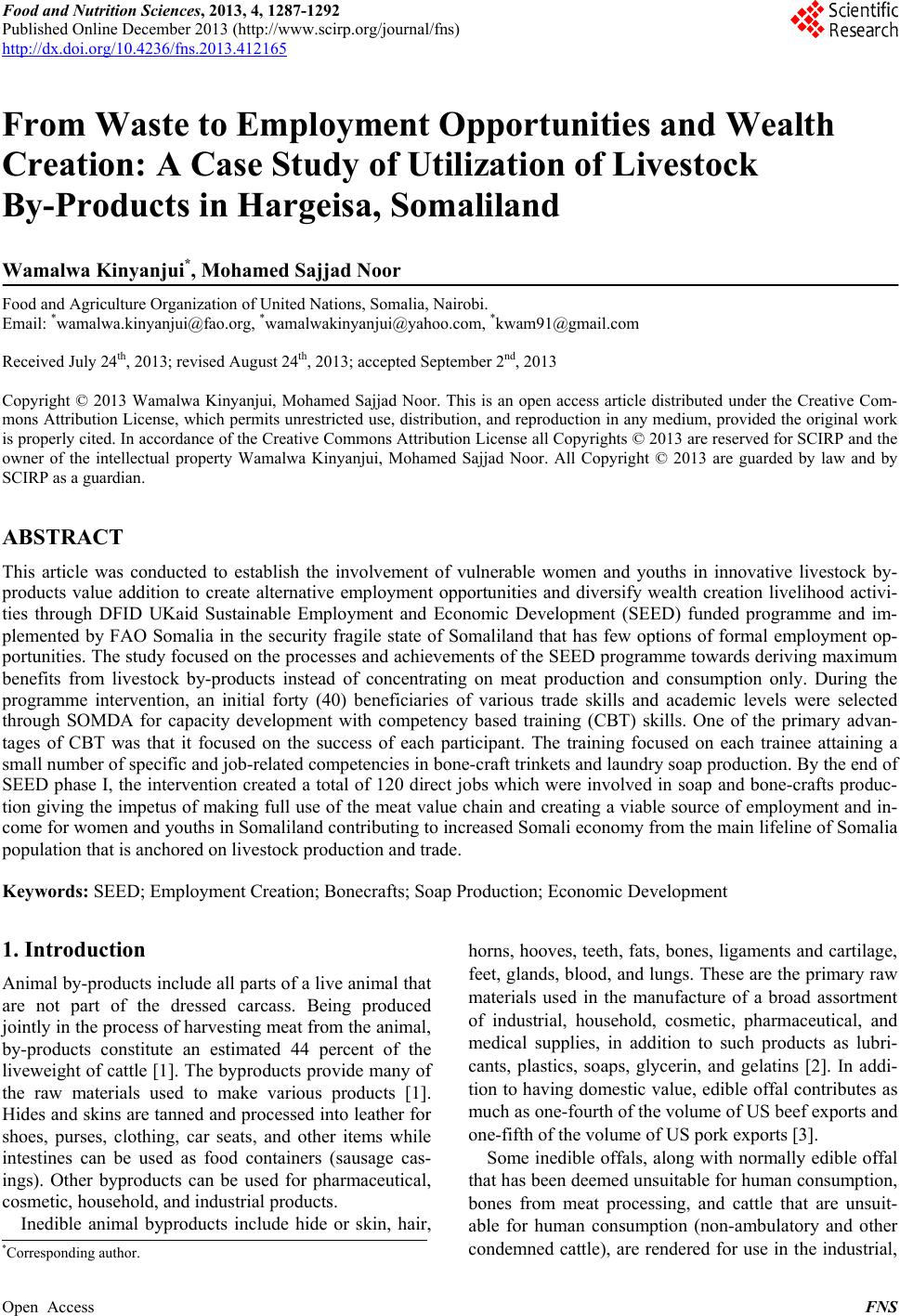 Food and Nutrition Sciences, 2013, 4, 1287-1292 Published Online December 2013 (http://www.scirp.org/journal/fns) http://dx.doi.org/10.4236/fns.2013.412165 Open Access FNS From Waste to Employment Opportunities and Wealth Creation: A Case Study of Utilization of Livestock By-Products in Hargeisa, Somaliland Wamalwa Kinyanjui*, Mohamed Sajjad Noor Food and Agriculture Organization of United Nations, Somalia, Nairobi. Email: *wamalwa.kinyanjui@fao.org, *wamalwakinyanjui@yahoo.com, *kwam91@gmail.com Received July 24th, 2013; revised August 24th, 2013; accepted September 2nd, 2013 Copyright © 2013 Wamalwa Kinyanjui, Mohamed Sajjad Noor. This is an open access article distributed under the Creative Com- mons Attribution License, which permits unrestricted use, distribution, and reproduction in any medium, provided the original work is properly cited. In accordance of the Creative Commons Attribution License all Copyrights © 2013 are reserved for SCIRP and the owner of the intellectual property Wamalwa Kinyanjui, Mohamed Sajjad Noor. All Copyright © 2013 are guarded by law and by SCIRP as a guardian. ABSTRACT This article was conducted to establish the involvement of vulnerable women and youths in innovative livestock by- products value addition to create alternative employment opportunities and diversify wealth creation livelihood activi- ties through DFID UKaid Sustainable Employment and Economic Development (SEED) funded programme and im- plemented by FAO Somalia in the security fragile state of Somaliland that has few options of formal employment op- portunities. The study focused on the processes an d achievements of the SEED programme towards deriving maximum benefits from livestock by-products instead of concentrating on meat production and consumption only. During the programme intervention, an initial forty (40) beneficiaries of various trade skills and academic levels were selected through SOMDA for capacity development with competency based training (CBT) skills. One of the primary advan- tages of CBT was that it focused on the success of each participant. The training focused on each trainee attaining a small number of specific and job-related competencies in bone-craft trinkets and laundry soap production. By the end of SEED phase I, the intervention created a total of 120 direct jobs which were involved in soap and bone-crafts produc- tion giving the impetus of making full use of the meat value chain and creating a viable source of employment and in- come for women and youths in Somaliland contributing to increased Somali econo my from the main lifeline of Somalia population that is anchored on livestock production and trade. Keywords: SEED; Employment Creation; Bonecrafts; Soap Production; Economic Development 1. Introduction Animal by-products include all parts of a live animal that are not part of the dressed carcass. Being produced jointly in the process of harvesting meat from the animal, by-products constitute an estimated 44 percent of the liveweight of cattle [1]. The byprodu cts provide many of the raw materials used to make various products [1]. Hides and sk ins are tanned and processed into leather for shoes, purses, clothing, car seats, and other items while intestines can be used as food containers (sausage cas- ings). Other byproducts can be used for pharmaceutical, cosmetic, household, and industrial products. Inedible animal byproducts include hide or skin, hair, horns, hooves, teeth, fats, bones, ligaments and cartilag e, feet, glands, blood, and lungs. These are the primary raw materials used in the manufacture of a broad assortment of industrial, household, cosmetic, pharmaceutical, and medical supplies, in addition to such products as lubri- cants, plastics, soaps, glycerin, and gelatins [2]. In addi- tion to having domestic value, edible offal contributes as much as one-fourth of the volume of US beef exports and one-fifth of the volume of US pork exports [3]. Some inedible offals, along with normally edible offal that has been deemed unsuitable for human consumption, bones from meat processing, and cattle that are unsuit- able for human consumption (non-ambulatory and other condemned cattle), are rendered for use in the industrial, *Corresponding author. 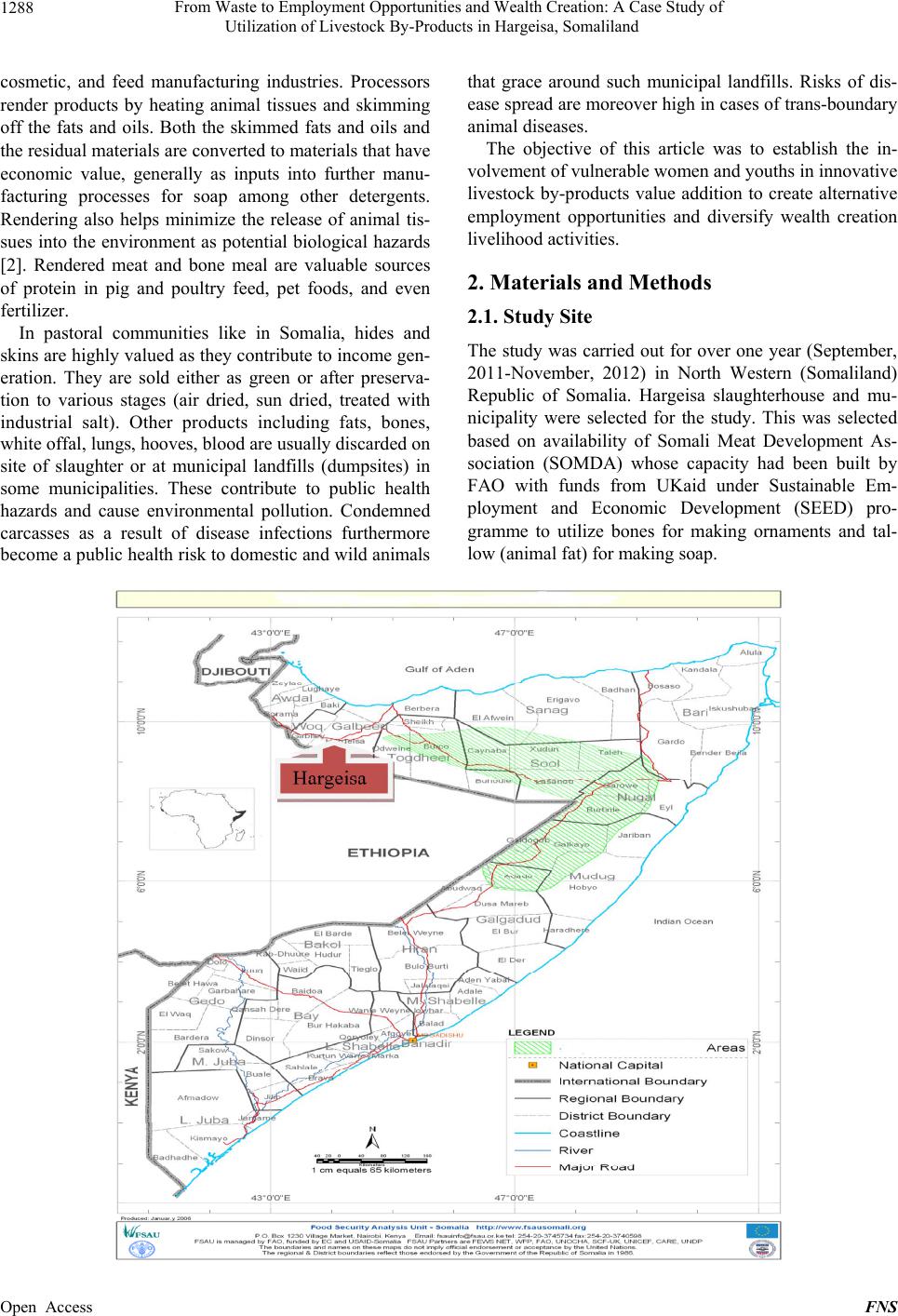 From Waste to Employment Opportunities and Wealth Creation: A Case Study of Utilization of Livestock By-Products in Hargeisa, Somaliland 1288 cosmetic, and feed manufacturing industries. Processors render products by heating animal tissues and skimming off the fats and oils. Both the skimmed fats and oils and the residual materials are converted to materials that have economic value, generally as inputs into further manu- facturing processes for soap among other detergents. Rendering also helps minimize the release of animal tis- sues into the environment as potential biological hazards [2]. Rendered meat and bone meal are valuable sources of protein in pig and poultry feed, pet foods, and even fertilizer. In pastoral communities like in Somalia, hides and skins are highly valued as they contribute to income gen- eration. They are sold either as green or after preserva- tion to various stages (air dried, sun dried, treated with industrial salt). Other products including fats, bones, white offal, lungs, hooves, blood are usually discarded on site of slaughter or at municipal landfills (dumpsites) in some municipalities. These contribute to public health hazards and cause environmental pollution. Condemned carcasses as a result of disease infections furthermore become a public health risk to domestic and wild an imals that grace around such municipal landfills. Risks of dis- ease spread are moreover high in cases of trans-boundary animal diseases. The objective of this article was to establish the in- volvement of vulnerable women and youths in innovative livestock by-products value addition to create alternative employment opportunities and diversify wealth creation livelihood activities. 2. Materials and Methods 2.1. Study Site The study was carried out for over one year (September, 2011-November, 2012) in North Western (Somaliland) Republic of Somalia. Hargeisa slaughterhouse and mu- nicipality were selected for the study. This was selected based on availability of Somali Meat Development As- sociation (SOMDA) whose capacity had been built by FAO with funds from UKaid under Sustainable Em- ployment and Economic Development (SEED) pro- gramme to utilize bones for making ornaments and tal- low (animal fat) for making soap. Open Access FNS  From Waste to Employment Opportunities and Wealth Creation: A Case Study of Utilization of Livestock By-Products in Hargeisa, Somaliland 1289 2.2. Data Collection This involved both qualitative and quantitative data col- lection methodologies. Secondary data collection involved reviewing of FAO’s literature in its database (FAO Somalia) and searching from the internet of relevant scientific papers. Primary data collection involved field visits to study area, application of semi-structured questionnaire to key informants of SOMDA officials, Somaliland government officials and focus group discussion with trainees, retail- ers of soap and the bone craft products. The question- naire aimed at obtaining information regarding voca- tional trainings received and types of equipments and tools provided to establish livestock by-products utiliza- tion. 3. Findings and Discussion 3.1. Interventions FAO Somalia through SEED programme funded by De- partmental Fund for International Development (DFID) of UKaid focused on creating economic wealth and em- ployment opportunities in Somalia, a country embroiled in conflict in Central/South of country and fragile stabil- ity in Northeast and Northwest parts of the country. The programme was targeting the vulnerable groups of women and young people in conflict affected communi- ties. The SEED Programme explored opportunities to develop new innovations and research in market devel- opment and foster improved access to markets as well as new employment creation opportunities along the meat value chain including livestock by-products. 3.2. Tour Learning Trips Learning tour in regional facilities to acquire hands-on experience in women and youth groups Cottage Industry within a Somali-set up in Kenya for promoting Bone Craft in Value Addition to Livestock by-products was undertaken by implementing FAO personnel to emulate practical lessons that could be integrated into the Enter- prise Development Programme that was being under- taken by FAO in Somaliland through SEED programme. One group in Kenya known as Bemos Craft Developers was found to specialize in production of artistic products primarily derived from bones (Cattle, Goats, Camels, Sheep, Fish), Cattle Horns, Wood and Metals, singly or mixed. The products included among others, flower vases, spoons, candle stands, key holders and a wide range of bone jewelleries, horn jewelleries and a variety of horn bracelets. Furthermore, the group was extracting bone marrow and fats to make ghee used for deep frying Somali traditional small meats. Bone craft enterp rise was found to be a viable option that could be undertaken by both Somali women and youth once trained to produce various products from horns and bones as a means of product diversification to create wealth and employment opportunities to fight the rampant poverty in Somaliland. 3.3. Capacity Development of Beneficiary Group An initial forty (40) beneficiaries of various trade skills and academic levels were selected through SOMDA de- velopment with competency based training (CBT) skills. One of the primary advantages of CBT was that it fo- cused on the success of each participant. The compe- tency-based approach was useful in training each trainee to attain a small number of specific and job-related com- petencies. These included CBT on soap making, bone hand crafts and Mugmad hygienic processing and pack- aging for 40 targeted beneficiaries at the start of the pro- gramme. An additional 80 participants were later re- cruited and given the same training by the end of the programme in July, 2012. The beneficiaries were ex- pected to be absorbed into private enterprises that devel- oped the livestock by-products on a commercial basis though on a small scale. The first 40 beneficiaries were trained in basic skills of bone marrow harvesting from the bones in addition to normal fats from the carcass. 3.4. Soap Production The beneficiaries were trained on how to make soap from the extracted bone marrow and other body fats from live- stock (Figure 1). The fats and extracted bone marrow were added into a measured quantity of water. An appro- priate quantity of caustic soda was added to the mixture. The mixture was boiled for about 2 - 3 hours. Along the boiling, a colouring agent of desired soap colour was added in addition to traditional perfume extracted from the local gum tree and resin giving the soap the natural scent. The resultant mixture after boiling was stirred until it started becoming thick. At this stage it was emptied Figure 1. Bone marrow and fats harvesting fr om bone s. Open Access FNS 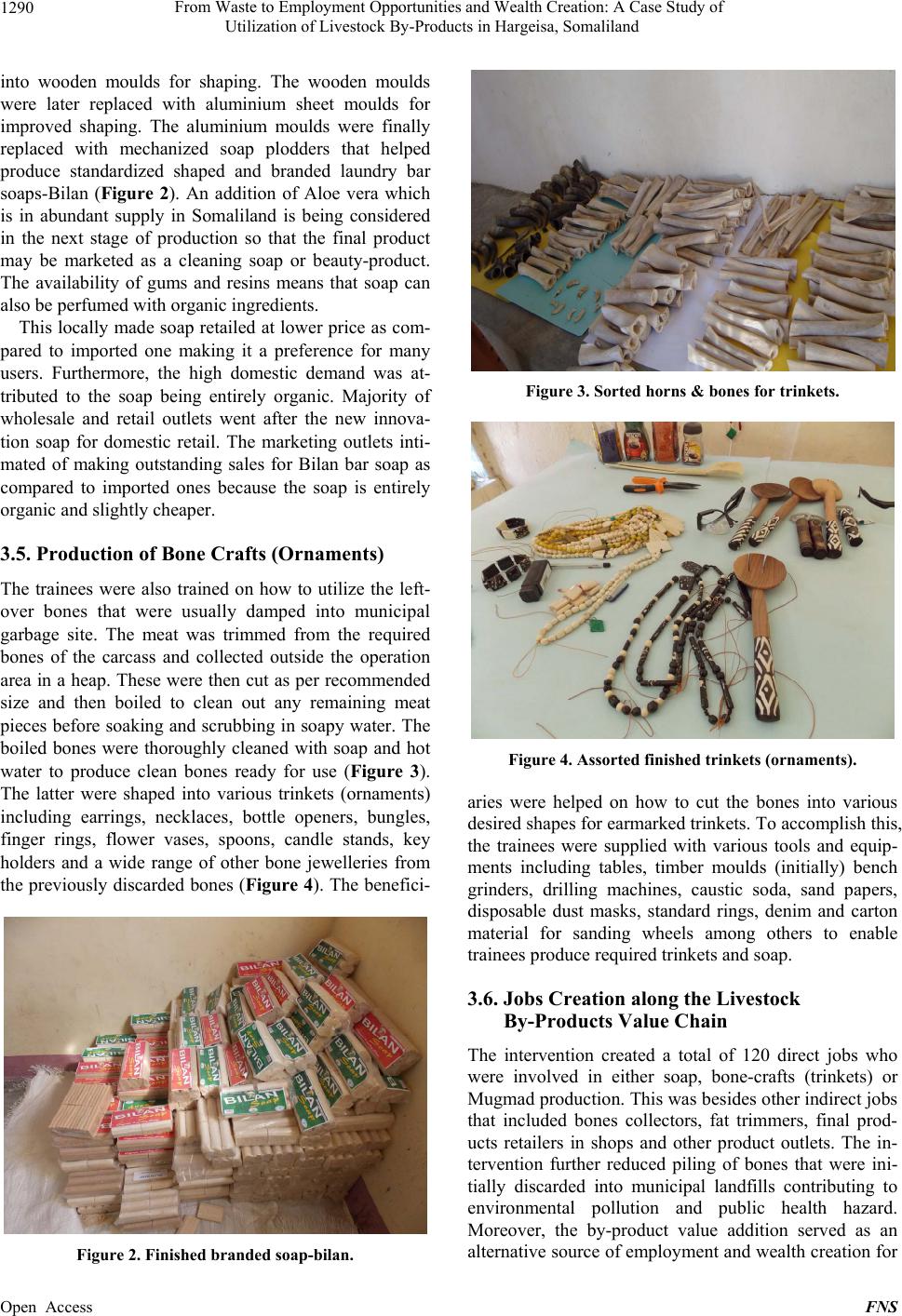 From Waste to Employment Opportunities and Wealth Creation: A Case Study of Utilization of Livestock By-Products in Hargeisa, Somaliland 1290 into wooden moulds for shaping. The wooden moulds were later replaced with aluminium sheet moulds for improved shaping. The aluminium moulds were finally replaced with mechanized soap plodders that helped produce standardized shaped and branded laundry bar soaps-Bilan (Figure 2). An addition of Aloe vera which is in abundant supply in Somaliland is being considered in the next stage of production so that the final product may be marketed as a cleaning soap or beauty-product. The availability of gums and resins means that soap can also be perfumed with organ ic ingredients. This locally made soap retailed at lower price as com- pared to imported one making it a preference for many users. Furthermore, the high domestic demand was at- tributed to the soap being entirely organic. Majority of wholesale and retail outlets went after the new innova- tion soap for domestic retail. The marketing outlets inti- mated of making outstanding sales for Bilan bar soap as compared to imported ones because the soap is entirely organic and slightly cheaper. 3.5. Production of Bone Crafts (Ornaments) The trainees were also trained on how to utilize the left- over bones that were usually damped into municipal garbage site. The meat was trimmed from the required bones of the carcass and collected outside the operation area in a heap. These were then cut as per recommended size and then boiled to clean out any remaining meat pieces before soaking and scrubbing in soapy water. The boiled bones were thoroughly cleaned with soap and hot water to produce clean bones ready for use (Figure 3). The latter were shaped into various trinkets (ornaments) including earrings, necklaces, bottle openers, bungles, finger rings, flower vases, spoons, candle stands, key holders and a wide range of other bone jewelleries from the previously discarded bones (Figure 4). The benefici- Figure 2. Finished brande d soap-bilan. Figure 3. Sorted horns & bones for trinkets. Figure 4. Assorted finished trinkets (ornaments). aries were helped on how to cut the bones into various desired shapes for earmarked trinkets. To accomplish th is, the trainees were supplied with various tools and equip- ments including tables, timber moulds (initially) bench grinders, drilling machines, caustic soda, sand papers, disposable dust masks, standard rings, denim and carton material for sanding wheels among others to enable trainees produce required trinkets and soap. 3.6. Jobs Creation along the Livestock By-Products Value Chain The intervention created a total of 120 direct jobs who were involved in either soap, bone-crafts (trinkets) or Mugmad production. This was besides other indirect jobs that included bones collectors, fat trimmers, final prod- ucts retailers in shops and other product outlets. The in- tervention further reduced piling of bones that were ini- tially discarded into municipal landfills contributing to environmental pollution and public health hazard. Moreover, the by-product value addition served as an alternative source of employment and wealth creation for Open Access FNS 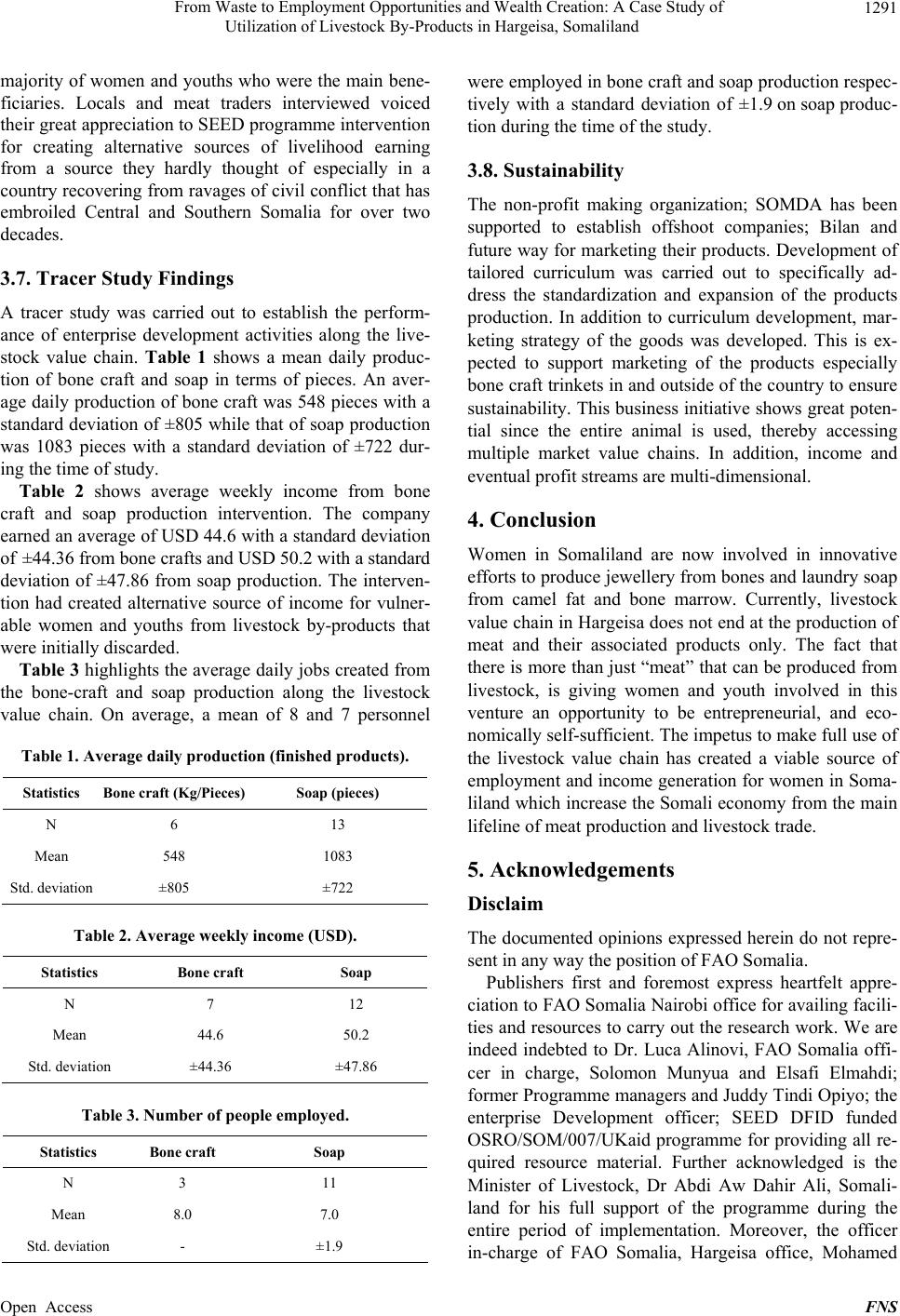 From Waste to Employment Opportunities and Wealth Creation: A Case Study of Utilization of Livestock By-Products in Hargeisa, Somaliland 1291 majority of women and youths who were the main bene- ficiaries. Locals and meat traders interviewed voiced their great appreciation to SEED programme intervention for creating alternative sources of livelihood earning from a source they hardly thought of especially in a country recovering from ravages of civil conflict that has embroiled Central and Southern Somalia for over two decades. 3.7. Tracer Study Findings A tracer study was carried out to establish the perform- ance of enterprise development activities along the live- stock value chain. Table 1 shows a mean daily produc- tion of bone craft and soap in terms of pieces. An aver- age daily production of bone craft was 548 pieces with a standard deviation of ±805 while that of soap production was 1083 pieces with a standard deviation of ±722 dur- ing the time of study. Table 2 shows average weekly income from bone craft and soap production intervention. The company earned an average of USD 44.6 with a standard deviation of ±44.36 from bone crafts and USD 50.2 with a standard deviation of ±47.86 from soap production. The interven- tion had created alternative source of income for vulner- able women and youths from livestock by-products that were initially discarded. Table 3 highlights the average daily jobs created from the bone-craft and soap production along the livestock value chain. On average, a mean of 8 and 7 personnel Table 1. Average daily production (finishe d pr oduc ts). Statistics Bone craft (Kg/Pieces) Soap (pieces) N 6 13 Mean 548 1083 Std. deviation ±805 ±722 Table 2. Average weekly income (USD). Statistics Bone craft Soap N 7 12 Mean 44.6 50.2 Std. deviation ±44.36 ±47.86 Table 3. Number of people employed. Statistics Bone craft Soap N 3 11 Mean 8.0 7.0 Std. deviation - ±1.9 were employed in bone craft and soap production respec- tively with a standard deviation of ±1.9 on soap produc- tion during the time of the study. 3.8. Sustainability The non-profit making organization; SOMDA has been supported to establish offshoot companies; Bilan and future way for marketing their products. Development of tailored curriculum was carried out to specifically ad- dress the standardization and expansion of the products production. In addition to curriculum development, mar- keting strategy of the goods was developed. This is ex- pected to support marketing of the products especially bone craft trinkets in and outside of the country to ensure sustainability. This business initiative shows great poten- tial since the entire animal is used, thereby accessing multiple market value chains. In addition, income and eventual profit streams are multi-dimensional. 4. Conclusion Women in Somaliland are now involved in innovative efforts to produce jewellery from bones and laundry soap from camel fat and bone marrow. Currently, livestock value chain in Hargeisa does not end at the production of meat and their associated products only. The fact that there is more than just “meat” that can be produced from livestock, is giving women and youth involved in this venture an opportunity to be entrepreneurial, and eco- nomically self-sufficient. The impetus to make full use of the livestock value chain has created a viable source of employment and income generation for women in Soma- liland which increase the Somali economy from the main lifeline of meat production and livestock trade. 5. Acknowledgements Disclaim The documented opinions expressed herein do not repre- sent in any way the position of FAO Somalia. Publishers first and foremost express heartfelt appre- ciation to FAO Somalia Nairobi office for availing facili- ties and resources to carry out the research work. We are indeed indebted to Dr. Luca Alinovi, FAO Somalia offi- cer in charge, Solomon Munyua and Elsafi Elmahdi; former Programme man agers and Juddy Tindi Op iyo; the enterprise Development officer; SEED DFID funded OSRO/SOM/00 7/UKaid programme for providing all re- quired resource material. Further acknowledged is the Minister of Livestock, Dr Abdi Aw Dahir Ali, Somali- land for his full support of the programme during the entire period of implementation. Moreover, the officer in-charge of FAO Somalia, Hargeisa office, Mohamed Open Access FNS 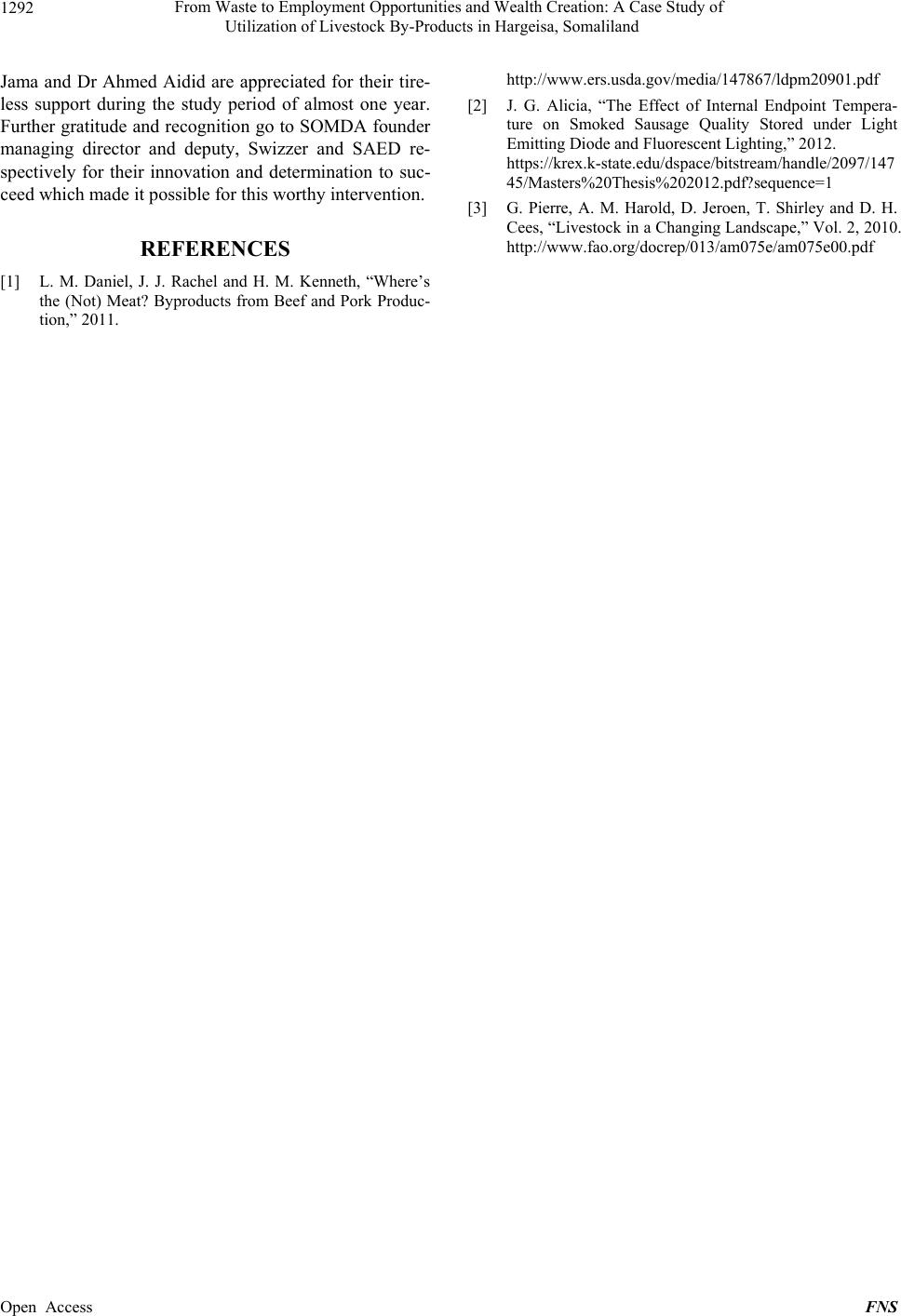 From Waste to Employment Opportunities and Wealth Creation: A Case Study of Utilization of Livestock By-Products in Hargeisa, Somaliland Open Access FNS 1292 Jama and Dr Ahmed Aidid are appreciated for their tire- less support during the study period of almost one year. Further gratitude and recognition go to SOMDA founder managing director and deputy, Swizzer and SAED re- spectively for their innovation and determination to suc- ceed which made it possible for this worthy intervention. REFERENCES [1] L. M. Daniel, J. J. Rachel and H. M. Kenneth, “Where’s the (Not) Meat? Byproducts from Beef and Pork Produc- tion,” 2011. http://www.ers.usda.gov/media/147867/ldpm20901.pdf [2] J. G. Alicia, “The Effect of Internal Endpoint Tempera- ture on Smoked Sausage Quality Stored under Light Emitting Diode and Fluorescent Lighting,” 2012. https://krex.k-state.edu/dspace/bitstream/handle/2097/147 45/Masters%20Thesis%202012.pdf?sequence=1 [3] G. Pierre, A. M. Harold, D. Jeroen, T. Shirley and D. H. Cees, “Livestock in a Changing Landscape,” Vol. 2, 2010. http://www.fao.org/docrep/013/am075e/am075e00.pdf |

